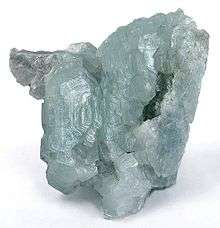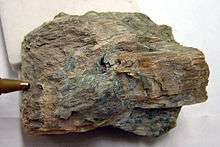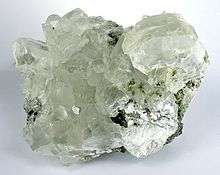Brucite
| Brucite | |
|---|---|
 | |
| General | |
| Category | Oxide mineral |
| Formula (repeating unit) | Mg(OH)2 |
| Strunz classification | 4.FE.05 |
| Crystal system | Trigonal |
| Crystal class |
Hexagonal scalenohedral (3m) H-M symbol: (3 2/m) |
| Space group | P3m1 |
| Unit cell | a = 3.142(1) Å, c = 4.766(2) Å; Z = 1 |
| Identification | |
| Color | White, pale green, blue, gray; honey-yellow to brownish red |
| Crystal habit | Tabular crystals; platy or foliated masses and rosettes – fibrous to massive |
| Cleavage | Perfect on {0001} |
| Fracture | Irregular |
| Tenacity | Sectile |
| Mohs scale hardness | 2.5 to 3 |
| Luster | Vitreous to pearly |
| Streak | White |
| Diaphaneity | Transparent |
| Specific gravity | 2.39 to 2.40 |
| Optical properties | Uniaxial (+) |
| Refractive index |
nω = 1.56–1.59 nε = 1.58–1.60 |
| Birefringence | 0.02 |
| Other characteristics | Pyroelectric |
| References | [1][2][3] |
Brucite is the mineral form of magnesium hydroxide, with the chemical formula Mg(OH)2. It is a common alteration product of periclase in marble; a low-temperature hydrothermal vein mineral in metamorphosed limestones and chlorite schists; and formed during serpentinization of dunites. Brucite is often found in association with serpentine, calcite, aragonite, dolomite, magnesite, hydromagnesite, artinite, talc and chrysotile.
It adopts a layered CdI2-like structure with hydrogen-bonds between the layers.[4]
Discovery


Brucite was first described in 1824 and named for the discoverer, American mineralogist, Archibald Bruce (1777–1818). A fibrous variety of brucite is called nemalite. It occurs in fibers or laths, usually elongated along [1010], but sometimes [1120] crystalline directions.
Occurrence
A notable location in the U.S. is Wood's Chrome Mine, Cedar Hill Quarry, Lancaster County, Pennsylvania. Yellow and white brucite with a botryoidal habit has been found in Kharan District, Pakistan.[5] Brucite also occurs in the Bela Ophiolite of Khuzdar District, Pakistan.[6]
Industrial applications
2Xray.jpg)
Synthetic brucite is mainly consumed as a precursor to magnesia (MgO), a useful refractory insulator. It finds some use as a flame retardant because it thermally decomposes to release water in a similar way to aluminium hydroxide and mixtures of huntite and hydromagnesite.[7][8] It also constitutes a significant source of magnesium for industry.
Magnesium attack of cement and concrete
When cement or concrete are exposed to Mg2+, the neoformation of brucite, an expansive material, may induce mechanical stress in the hardened cement paste or may clog the porous system creating a buffering effect and delaying deterioration of the CSH phase into MSH phase. The exact magnitude of impact that brucite has over cement paste is still debatable. Prolonged contact between sea water or brines and concrete may induce durability issue although high concentrations are required for this effect, which are rare to find in nature.
The use of dolomite as aggregate in concrete can also cause magnesium attack and should be avoided.
See also
References
- ↑ Brucite on Mindat.org
- ↑ Handbook of Mineralogy
- ↑ Brucite on Webmineral
- ↑ Greenwood, Norman N.; Earnshaw, Alan (1997). Chemistry of the Elements (2nd ed.). Butterworth-Heinemann. ISBN 0-08-037941-9.
- ↑ "Brucite from Kharan, Kharan District, Balochistan (Baluchistan), Pakistan". minfind.com. Retrieved 21 February 2017.
- ↑ Bashir et al., Mineralogy of the Kraubath-type magnesite deposits of the Khuzdar area, Baluchistan, Pakistan, Journal of the Earth Sciences Application and Research Centre of Hacettepe University, Yerbilimleri, 30 (3), 169–180. Accessed February 20, 2017
- ↑ Hollingbery, LA; Hull TR (2010). "The Thermal Decomposition of Huntite and Hydromagnesite - A Review". Thermochimica Acta. 509 (1–2): 1–11. doi:10.1016/j.tca.2010.06.012.
- ↑ Hollingbery, LA; Hull TR (2010). "The Fire Retardant Behaviour of Huntite and Hydromagnesite - A Review". Polymer Degradation and Stability. 95 (12): 2213–2225. doi:10.1016/j.polymdegradstab.2010.08.019.
Further reading
- Lee, Hyomin; Robert D. Cody; Anita M. Cody; Paul G. Spry (2000). "Effects of various deicing chemicals on pavement concrete deterioration" (PDF). Mid-Continent Transportation Symposium 2000 Proceedings. Archived from the original (PDF) on March 20, 2009. Retrieved 2009-09-10.
- Lee, Hyomin; Robert D. Cody; Anita M. Cody; Paul G. Spry (2002). "Observations on brucite formation and the role of brucite in Iowa highway concrete deterioration". Environmental and Engineering Geoscience. 8 (2): 137–145. doi:10.2113/gseegeosci.8.2.137. Retrieved 2009-09-10.
- Wies aw, W; Kurdowski (September 2004). "The protective layer and decalcification of C-S-H in the mechanism of chloride corrosion of cement paste". Cement and Concrete Research. 34 (9): 1555–1559. doi:10.1016/j.cemconres.2004.03.023.
- Biricik, Hasan; Fevziye Aköz; Fikret Türker; Ilhan Berktay (2000). "Resistance to magnesium sulfate and sodium sulfate attack of mortars containing wheat straw ash". Cement and Concrete Research. 30 (8): 1189–1197. doi:10.1016/S0008-8846(00)00314-8.